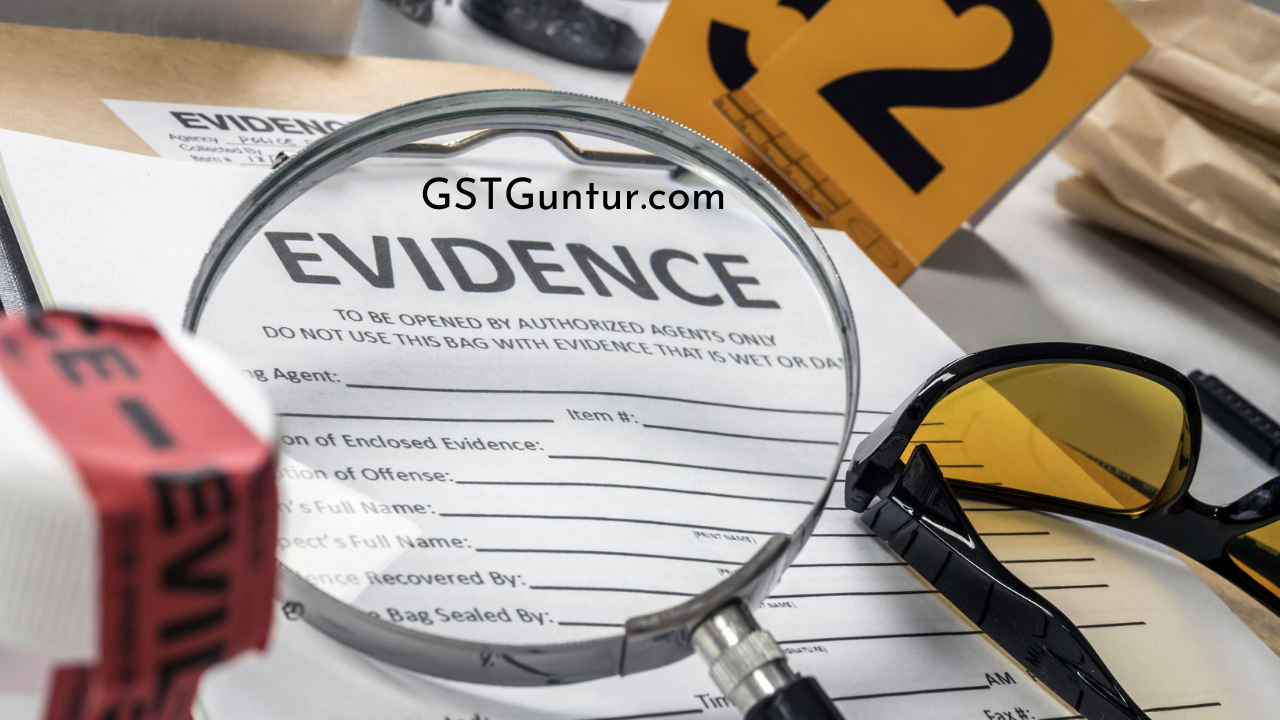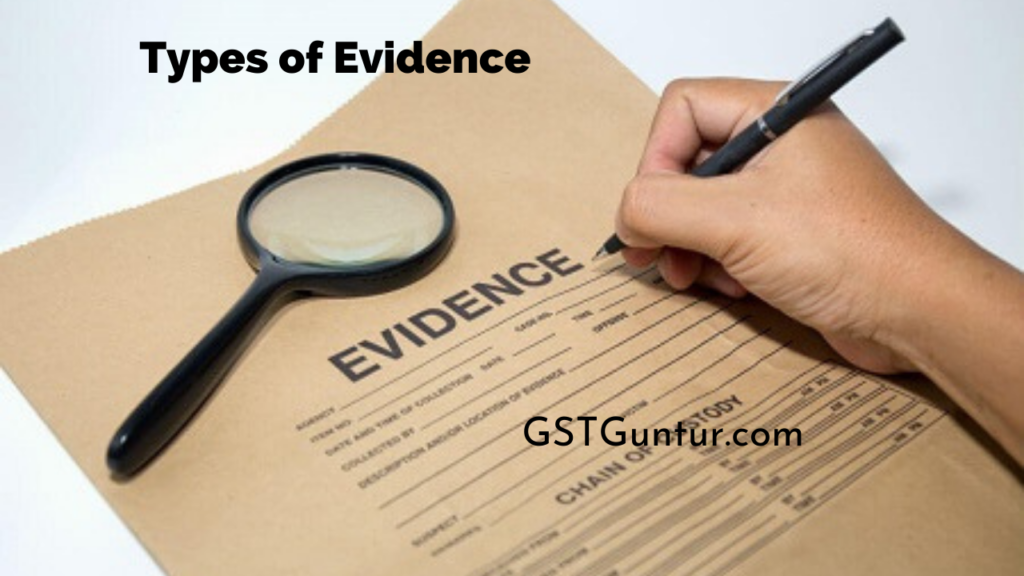Types Evidence: When it comes to hearing cases in the Court of law, Evidence acts as the only source to prove a crime. Evidence comes from the Latin word “evidere”, which translates to proof or show clearly the existence or happening of specific events. Evidence is considered an essential source of proving a crime in the Court of law.
The Indian constitution has a separate act for evidence, known as the Indian Evidence Act, which throws light on how and which evidence can be produced in front of the Court of Law while hearing a case. It also provides a list of all the acceptable or unacceptable evidence in the Court of Law. There are various types of evidence that are mentioned in the Indian Evidence Act. In this article, we will discuss each type of evidence in detail.
- What is an Evidence?
- Types of Evidence
- Oral Evidence
- Documentary Evidence
- Primary Evidence
- Secondary Evidence
- Real Evidence
- Hearsay Evidence
- Direct Evidence
- Circumstantial or Indirect Evidence
What is an Evidence?
Evidence can be defined as any element of information or fact that indicates the happening or occurrence of a specific event. Evidence means to show, prove, or discover facts of particular circumstances. Evidence acts as a strong source to prove the guilt and convict a person in the Court of Law.
Types of Evidence
As per the Indian Evidence Act, there are various types of Evidence depending on the case and circumstances. All the types of Evidence mentioned in the Indian Evidence Act are acceptable in the Court of Law. Let’s explore each type in detail.
Oral Evidence
Oral Evidence refers to all those statements of proof that witnesses give in the Court of Law. All the Oral evidence to be presented while hearing a case must be approved or mentioned in the Indian Evidence Act. Section 59 of the India Evidence Act states that all the statements except those mentioned in a document or present in electronic records can be considered Oral Evidence in the Court of Law.
Suppose witnesses cannot give their statement orally due to physical disabilities-,. In that case, there are provisions in the act that suggest those witnesses can give their statement in writing or any other way, which would fall under oral evidence. According to the Indian Evidence Act, oral evidence given in any other format by witnesses with speaking disorders cannot be dismissed or disbanded based on the non-submission of medical reports for such disability.
The Indian Evidence Act, in its section 60, suggests the following rules and regulations for a shred of Oral evidence:
- If the proof or the act can be seen, the evidence must come from a person who says he/she has seen it.
- If the proof or the act could be heard, the evidence must come from a person who says he/she has heard it.
- If the proof or the act can be perceived by any other sense, then the evidence must come from a person who says he/she has felt or perceived it.
- If the proof is based on opinion or on the ground to which the opinion is subjected, then the evidence must come from a person who holds those opinions on those grounds.
Documentary Evidence
According to an ancient Roman Proverb, spoken word vanishes, but written word remains. Similarly, written Documentary Evidence is given foremost priority than Oral Evidence in the Court of Law. Documentary Evidence is more believable or acceptable as it cannot be changed, unlike Oral evidence.
According to Section 3 of the Indian Evidence Act, documentary evidence refers to all those documents, including electronic documents or records submitted in the Courtroom for the verification or validity of a case. According to the Evidence laws, documents are divided into two categories; Public Documents and Private Documents.
The Evidence law even states that the contents of documentary evidence must be proved by producing the original document, which is called Primary Evidence. The contents can also be proved by producing supporting documents, which is called Secondary Evidence.
Now, the question is What is Primary and Secondary Evidence? Let’s discuss each one in detail.
Primary Evidence
According to section 62 of the Indian Evidence Act, Primary Evidence is that document that contains the original contents of the evidence. Primary Evidence is the most acceptable and superior evidence in the Court of Law. Primary Evidence is the Original content or document submitted in the Courtroom for verification of a hearing. Following are the key characteristics of Primary Evidence:
- Primary Evidence must be an original copy of the document.
- If a document is executed or implemented in several parts, each part is considered as the primary document of the evidence.
- If a document is implemented in counterparts, each counter acts as a piece of Primary evidence against the parties signing it.
- When a single process creates several documents from the original document, then they are considered as the copy of the original document and not as the Primary Evidence. For example, copies of original documents created by printing or photography.
Secondary Evidence
Secondary evidence is the supporting document presented before the Court of Law in the absence of the Primary Evidence. Section 63 of the Indian Evidence Act states the contents of Secondary Evidence, which are as follows:
- Certified copies of the original document.
- Copies of the original document made by mechanical process and compared with the original document.
- Counterparts of the original document can act as evidence against parties who did not implement them.
- Oral statement of the contents of the original document by a witness who saw the original document.
If any of the parties involved in a case want to prove a fact by using Secondary evidence, they must abide by the conditions mentioned in Section 65 of the Act. Section 65 of the Indian Evidence Act states that a fact can be proved by using Secondary Evidence in the following conditions:
- If the primary document is in possession of a person against whom the fact is to be proved. It can also be proved if it is with any other person who is out of reach of the court, or it is in possession of a person who has not produced it before the Court even after due notice.
- If the primary document is lost or destroyed.
- If the primary evidence is of such a nature, it cannot be moved from one location to another.
- If the existence, contents, or condition of the Primary evidence have been proven to be in writing.
- If the Primary evidence is a Public Document proved by section 74.
- If the Original or Primary evidence is a document of which, a certified copy is permissible.
- If the Original or Primary document consists of various other documents, which does not concern the specific case.
Real Evidence
Real Evidence, also known as Physical Evidence, is the subject or facts that the Court can see or touch. Real Evidence includes objects or items that are physically presented before the Court of Law for inspection. Examples of real evidence can be fingerprints, blood samples, weapons or instruments used in the crime, or other physical objects. Real evidence has a superior advantage over any other form of evidence. However, the item of real evidence must be authentic.

Hearsay Evidence
Hearsay is another type of evidence that is considered as indirect evidence in the Court of Law. Hearsay evidence refers to statements given by witnesses that are not based on their personal knowledge or experience but on what they heard from others regarding the fact or case. The statement of such a witness is unacceptable to prove the validity of the fact.
Hearsay evidence is not acceptable in the Court of Law for the following reasons:
- The person giving a Hearsay evidence may not be directly involved in the case or does not carry the responsibility to prove the fact.
- In a Hearsay evidence, the truth vanishes or diminishes with each repetition of the evidence.
- The evidence may be based on false rumours being spread to hide the validity of the fact.
However, there are certain exceptions to the Hearsay evidence, they are:
- Section 6 of the Indian Evidence Act suggests that a statement of evidence can be proved through another person who is a witness to the statement as a part of the transaction issue.
- Section 74 of the Indian Evidence Act states that the statement of a Public document such as official books or registers can be proved by producing the document; instead of producing the draftsman of such document.
- Section 17 – Section 23 and Section 24 – Section 30 provide exceptions to Hearsay evidence on the grounds of Admission and Confession.
- Section 32 (1) of the Indian Evidence Act states that the dying declaration of a dead person can be produced as a Hearsay evidence if the cause of death of such person comes into question.
- Section 33 of the Indian Evidence Act states that statements of former proceedings are acceptable as Hearsay Evidence.
Direct Evidence
Direct evidence refers to that evidence that will prove the fact without the interpretation of the circumstances. It includes all those pieces of evidence directly related to a specific case and does not require the Judge to make assumptions to reach conclusions. For example, in a shoot-out case, the eyewitness who saw the accused fire at the victim can serve as Direct evidence. Footage of a security cam showing the proof of a crime can be direct evidence.
Circumstantial or Indirect Evidence
Circumstantial evidence, also known as Indirect evidence, refers to those objects or facts that rely on a medium of connection to reach the final conclusion in a case. An example of Indirect evidence can be a fingerprint obtained from the crime scene.
Circumstantial evidence plays a vital role in criminal and civil cases with a lack of Direct evidence.
In The End…
Pieces of evidence play a significant role in proving the happening or non-happening of specific events. They act as the guiding light in proving the guilt or innocence of a person convicted in a criminal case.
